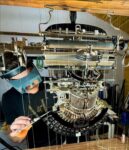John Peralta, the brilliant artist behind Professor Fox’s Fantastic Writing Machine was very kind to answer a few burning questions about his Hammond installation. (edited slightly for clarity)

“I first fell in love with Hammond’s at the home of a friend in Austin who is an avid collector of Hammond’s and Blickensderfer’s. I now own two – this one and another multiplex in pristine condition. Based on the serial number (107193) the best i could determine this particular Hammond is a multiplex from circa 1913. But you could probably better date it than i can. It came only with a paper label on the back that read: property of john fox, and his address. Through research i learned that he was a professor at Harvard and that he passed away a few years ago.”
“I’ve done quite a few typewriters now, and I’ve collected quite a few over the years. I’m drawn equally to their beautiful designs and their utilitarian purpose. They also hold sentimental value for me, which is why i believe my clients are drawn to them as well. It amazes me that there were so many ingenious innovations over the years, like the various different keyboard configurations, from a multitude of manufacturers. Yet only a few survived past the advent of the computer.”

John first became interested in the exploded view in 2005, while living in Asia. He “came across an exploded diagram of a bicycle on the back of a magazine” and “was inspired by its fragile beauty, and imagined a three-dimensional version with a physical object.” He continued “I went home and rifled through my desk and found an old pocket watch. That was to be my very first piece. Using only a ruler and simple tools, which i still use today, i developed my own techniques for suspension for exposing the inner workings of these humble machines.”
How do you choose your sculptures?
“The subjects I choose for my sculptures, like typewriters and sewing machines, are typically icons of utility and invention. I also like to think they hold memories we’ve long forgotten. They’ve watched generations pass; recorded every scene, love letter, and document. Each image, word, and note is permanently imprinted on them.”

What process do you follow and how long did Professor Fox’s Hammond take?
“My process involves close examination of the object to understand how it works and how i want to display it. I do as much research online as possible. It’s always helpful if there is any ephemera included, it can be helpful with recreating a provenance or building a story. I then disassemble the object and clean it. I do some repair and restoration only as really necessary. I like to preserve much of the wear as it represents the “memories” of the previous owner. I lay out the components on my work bench it the configuration i want to display it and take measurements for the framing. I then construct the display frame or case in steel, wood, or other materials. And finally begin the work of suspending the pieces. There’s a lot of decision making at every point in the process. The whole project typically takes 300-400 hours from start to finish, depending on the piece.”
John’s next pieces are “the electric guitar Robby Krieger played on the doors’ first album, and a post WWII submarine periscope.”
Currently his work is on display in galleries in Los Angeles, Austin, Dallas, Strasbourg, and Aix-en-Provance, France.
